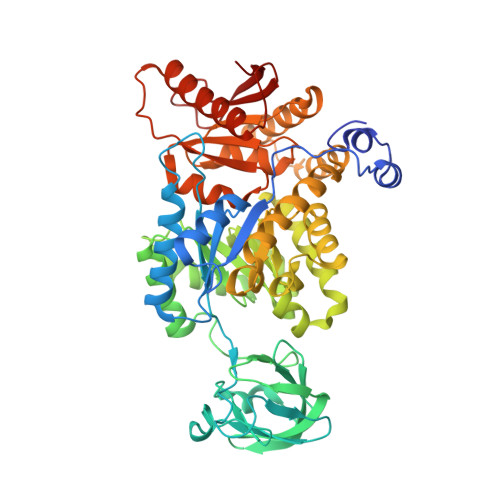Differentiating a Ligand's Chemical Requirements for Allosteric Interactions from Those for Protein Binding. Phenylalanine Inhibition of Pyruvate Kinase.
Williams, R., Holyoak, T., McDonald, G., Gui, C., Fenton, A.W.(2006) Biochemistry 45: 5421-5429
- PubMed: 16634623
- DOI: https://doi.org/10.1021/bi0524262
- Primary Citation of Related Structures:
2G50 - PubMed Abstract:
The isoform of pyruvate kinase from brain and muscle of mammals (M(1)-PYK) is allosterically inhibited by phenylalanine. Initial observations in this model allosteric system indicate that Ala binds competitively with Phe, but elicits a minimal allosteric response. Thus, the allosteric ligand of this system must have requirements for eliciting an allosteric response in addition to the requirements for binding. Phe analogues have been used to dissect what chemical properties of Phe are responsible for eliciting the allosteric response. We first demonstrate that the l-2-aminopropanaldehyde substructure of the amino acid ligand is primarily responsible for binding to M(1)-PYK. Since the allosteric response to Ala is minimal and linear addition of methyl groups beyond the beta-carbon increase the magnitude of the allosteric response, we conclude that moieties beyond the beta-carbon are primarily responsible for allostery. Instead of an all-or-none mechanism of allostery, these findings support the idea that the bulk of the hydrophobic side chain, but not the aromatic nature, is the primary determinant of the magnitude of the observed allosteric inhibition. The use of these results to direct structural studies has resulted in a 1.65 A structure of M(1)-PYK with Ala bound. The coordination of Ala in the allosteric amino acid binding site confirms the binding role of the l-2-aminopropanaldehyde substructure of the ligand. Collectively, this study confirms that a ligand can have chemical regions specific for eliciting the allosteric signal in addition to the chemical regions necessary for binding.
Organizational Affiliation:
Department of Biochemistry and Molecular Biology, The University of Kansas Medical Center, Kansas City, Kansas 66160, USA.






















